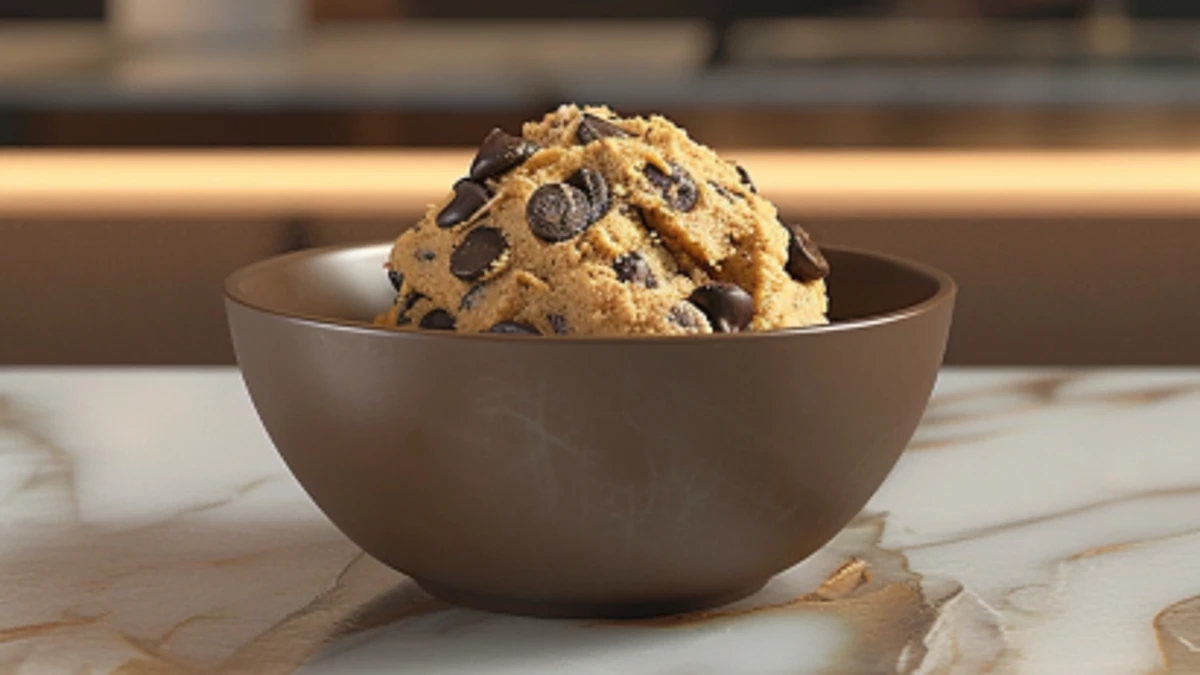What Is Cookie Dough Made Of?
Cookie dough is a delectable blend of ingredients that form the base for cookies. The primary components of cookie dough include:
- Flour: The foundation of cookie dough, providing structure.
- Butter: Adds richness and flavor, also contributing to the dough’s texture.
- Sugar: Typically a mix of granulated and brown sugar for sweetness and moisture.
- Eggs: Act as a binder, adding moisture and aiding in the leavening process.
- Leavening Agents: Such as baking soda or baking powder, to help the cookies rise.
- Flavorings: Vanilla extract is common, with other flavors like almond extract or spices added depending on the recipe.
- Mix-Ins: Chocolate chips, nuts, dried fruits, and other ingredients that add texture and flavor.
These ingredients combine to create the dough that we shape and bake into cookies. The balance and quality of these ingredients are crucial for the texture and taste of the final baked product.
Can You Eat Raw Cookie Dough?
The simple answer to whether you can eat raw cookie dough is: it depends. Traditional cookie dough poses two main risks when consumed raw:
- Raw Eggs: They can harbor Salmonella bacteria, which can cause food poisoning.
- Raw Flour: Uncooked flour can contain E. coli bacteria.
However, there are safe alternatives for those who can’t resist the temptation of raw cookie dough:
- Edible Cookie Dough: This variant uses heat-treated flour and omits eggs or substitutes them with pasteurized egg products.
- Egg-Free Recipes: Some recipes use alternatives like yogurt or applesauce, reducing the risk associated with raw eggs.
It’s important to ensure that any raw dough you consume is made with safe ingredients to avoid potential health risks.

Is Cookie Dough and Cookie Batter the Same?
Cookie dough and cookie batter are often confused but differ in their consistency and intended use:
- Cookie Dough:
- Consistency: Thick and moldable.
- Use: Typically scooped or rolled into balls and then baked.
- Texture: Holds its shape during baking, resulting in cookies with a defined structure.
- Cookie Batter:
- Consistency: Thinner, pourable.
- Use: Poured or spread onto baking sheets or into molds.
- Texture: Results in a more cake-like or brownie-like texture rather than a traditional cookie.
The choice between dough and batter depends on the desired final product. Cookie dough is for traditional cookies, while cookie batter is used for recipes where a lighter, softer texture is desired.
Easy Taco Casserole Recipe | Hearty and Delicious Mexican Dish
How Should My Cookie Dough Be?
Achieving the perfect cookie dough involves paying attention to several key factors:
- Texture:
- Smooth and Homogeneous: Well-mixed without lumps.
- Firm but Pliable: Should be easy to shape without being too sticky.
- Consistency:
- Not Too Dry: Should hold together without crumbling.
- Not Too Wet: Should not be overly sticky or difficult to handle.
- Temperature:
- Chilled Dough: Helps maintain shape during baking and enhances flavor development. Chilling the dough for at least 30 minutes before baking is often recommended.
- Appearance:
- Uniformity: Evenly distributed ingredients, ensuring every bite has the perfect mix of flavors.
Following these guidelines ensures that your cookie dough will bake into delicious, perfectly textured cookies.
Conclusion
Cookie dough is a versatile and beloved ingredient in many kitchens. Understanding what goes into making it, the safety considerations of eating it raw, and the differences between dough and batter can help you master your baking. By focusing on texture, consistency, and temperature, you can create cookie dough that bakes into perfect cookies every time. Whether you enjoy it baked or raw (with safe ingredients), cookie dough remains a delightful treat that continues to captivate cookie lovers around the world.
The Ultimate Guide to Instant Pot Hard Boiled Eggs
Frequently Asked Questions
What is cookie dough made of?
Cookie dough is primarily made of flour, butter, sugar, eggs, leavening agents, flavorings, and mix-ins like chocolate chips or nuts.
Can you eat raw cookie dough?
You can eat raw cookie dough if it is made with pasteurized eggs or egg substitutes and heat-treated flour to avoid the risk of foodborne illnesses.
Is cookie dough and cookie batter the same?
No, cookie dough is thicker and moldable, intended for making traditional cookies, while cookie batter is thinner and pourable, used for softer, cake-like baked goods.
How should my cookie dough be?
Your cookie dough should be smooth, firm but pliable, not too dry or wet, and ideally chilled before baking for the best results.
What makes edible cookie dough safe?
Edible cookie dough is safe due to the use of heat-treated flour and pasteurized egg products or egg substitutes, eliminating the risk of harmful bacteria.
Why is it important to chill cookie dough?
Chilling cookie dough helps it hold its shape during baking, enhances flavor development, and can improve the texture of the final cookies.

The Versatility of Cookie Dough
Cookie dough’s versatility is one of its most appealing traits. Beyond traditional cookies, it can be used in various creative ways to delight your taste buds. Here are some popular uses of cookie dough:
- Cookie Dough Ice Cream: Bits of edible cookie dough mixed into creamy vanilla or chocolate ice cream.
- Cookie Dough Truffles: Rolled into balls, dipped in chocolate, and enjoyed as bite-sized treats.
- Cookie Dough Brownies: A layer of cookie dough spread over baked brownies for a decadent dessert.
- Cookie Dough Dip: A sweet dip made from edible cookie dough, perfect for serving with fruit, pretzels, or graham crackers.
Tips for Making the Best Cookie Dough
Creating the best cookie dough involves a few key tips and tricks that can enhance both flavor and texture:
- Quality Ingredients: Use high-quality butter, fresh eggs, and pure vanilla extract for the best flavor.
- Room Temperature Ingredients: Ensure that your butter and eggs are at room temperature for easier mixing and better consistency.
- Proper Mixing: Cream the butter and sugars together until light and fluffy before adding the eggs and dry ingredients.
- Measuring Flour Correctly: Spoon the flour into your measuring cup and level it off with a knife to avoid packing too much flour, which can lead to dry dough.
- Chill the Dough: Chilling the dough for at least 30 minutes helps prevent spreading during baking and intensifies the flavors.
Cookie Dough Storage Tips
Proper storage of cookie dough is essential to maintain its freshness and quality. Here are some tips for storing cookie dough:
- Refrigeration: Store cookie dough in an airtight container in the refrigerator for up to a week.
- Freezing: For longer storage, freeze the dough in portioned balls on a baking sheet. Once frozen, transfer the dough balls to a freezer-safe bag or container. Cookie dough can be frozen for up to three months.
- Thawing: When ready to bake, thaw frozen cookie dough in the refrigerator overnight or bake from frozen, adding a few extra minutes to the baking time.
Popular Cookie Dough Flavors
While classic chocolate chip cookie dough remains a favorite, there are many other delicious flavors to explore:
- Peanut Butter Cookie Dough: Rich and nutty, perfect for peanut butter lovers.
- Oatmeal Raisin Cookie Dough: Chewy and spiced with cinnamon and nutmeg.
- Double Chocolate Cookie Dough: Intensely chocolatey with cocoa powder and chocolate chunks.
- Sugar Cookie Dough: Simple and sweet, ideal for decorating.
- Snickerdoodle Cookie Dough: Cinnamon-flavored dough rolled in sugar for a sweet and spicy treat.
The Science Behind Cookie Dough
Understanding the science behind cookie dough can help you achieve perfect cookies every time:
- Butter: Provides flavor and moisture, creating a tender texture. When creamed with sugar, it helps incorporate air, making the dough lighter.
- Sugar: Sweetens the dough and aids in browning during baking. Different sugars (granulated, brown) contribute to texture and flavor.
- Eggs: Act as a binder, adding moisture and helping the dough rise. They also contribute to the richness of the cookies.
- Flour: Provides structure through gluten formation. The protein content of the flour affects the texture—higher protein flours result in chewier cookies, while lower protein flours yield tender cookies.
- Leavening Agents: Baking soda and baking powder cause the dough to rise, creating a light and airy texture.

Cookie Dough for Special Diets
For those with dietary restrictions, there are many ways to enjoy cookie dough:
- Gluten-Free Cookie Dough: Use gluten-free flour blends to make the dough suitable for those with gluten sensitivities.
- Vegan Cookie Dough: Substitute eggs with flaxseed meal or applesauce, and use plant-based butter or coconut oil.
- Keto Cookie Dough: Use almond flour and sugar substitutes like erythritol or stevia to create a low-carb version.
Cookie Dough FAQs
How can I make my cookie dough more flavorful?
Enhance the flavor by using high-quality ingredients, adding a pinch of salt, and chilling the dough to allow the flavors to meld.
What should I do if my cookie dough is too sticky?
If your cookie dough is too sticky, refrigerate it for 30 minutes or add a bit more flour, one tablespoon at a time, until the desired consistency is reached.
Can I bake frozen cookie dough directly?
Yes, you can bake frozen cookie dough directly. Just add a few extra minutes to the baking time.
What causes cookies to spread too much during baking?
Cookies spread too much if the dough is too warm or if there is too much butter or sugar. Chilling the dough before baking can help prevent excessive spreading.
How can I achieve chewy cookies?
To achieve chewy cookies, use more brown sugar than white sugar, add an extra egg yolk, and slightly underbake the cookies.
What are the best mix-ins for cookie dough?
Popular mix-ins include chocolate chips, nuts, dried fruit, toffee bits, and candy pieces. Be creative and experiment with different combinations!

